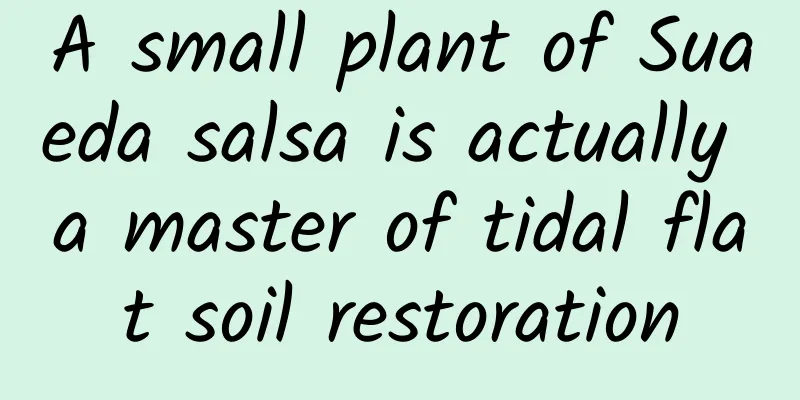A small plant of Suaeda salsa is actually a master of tidal flat soil restoration

|
Every autumn and winter, you can always see a giant "red carpet" in Panjin City, Liaoning Province. Its shape is like brocade, its flames are like fire, and seagulls are circling in the sky, creating a picturesque scenery. This beautiful "red carpet" is "woven" by Suaeda salsa. Suaeda salsa, also known as Suaeda salsa, is the "front row" plant closest to the seawater on the mudflats. Although it is inconspicuous, the densely connected clumps of Suaeda salsa can become one of the natural wonders seen from space. For example, the Red Beach Wetland Corridor at the mouth of the Liaohe River in the southwest of Panjin City, Liaoning Province is 18 kilometers long and is known as the "World Red Coastline". A "red beach" appeared near the Dagang Oilfield in Tianjin Binhai New Area. However, in recent years, due to factors such as changes in the coastline, rising salinity in soil and seawater, and climate and environmental changes, the area of the "red carpet" has shrunk. The exposed mudflats look like patches of ugly alopecia, and migratory birds have lost their places to forage and hide. In order to "retire from wetlands" and give birds a habitat, the relevant departments of Panjin City have actively implemented the Suaeda salsa restoration project, actively restoring the Suaeda salsa by dredging tidal channels, expanding water storage, replanting Suaeda salsa seeds, and releasing sandworms and mudskippers to open up biological migration channels. At present, the area of the red beach in the scenic corridor has increased to 22,000 acres this year, expanding more than 10 times in 5 years. In the city, Panjin has restored 577 hectares of degraded wetlands and 574 hectares of Suaeda salsa wetlands. As people retreat and birds come in, the list of bird species in Panjin wetlands has increased from more than 200 to 304 this year after the restoration of the natural ecology. More than 1 million water birds migrate, stop or breed in Panjin every year. The breeding population of black-headed gulls has increased from 1,200 in the early years to 11,696 this year, becoming one of the successful examples of endangered species protection in China. In the Bohai Sea, Suaeda salsa has transformed itself into the "pioneer defender" of coastline restoration. Bohai Sea is the only inland sea in my country. Its poor hydrodynamic conditions determine its limited self-purification capacity. Long-term pollution has caused serious damage to the ecological environment of Bohai Sea. Especially when the Liaohe Oilfield was built in the 1980s, in order to protect the oilfield facilities, the ground in some nearby places was hardened, causing the water of Daling River to swing back and forth, throwing silt to this side, and the riverside beach became a wasteland covered with silt. In response to this, the relevant departments of Jinzhou City actively adopted the Dalinghe Estuary Ecological Restoration Project. On the one hand, artificial breeding facilities were dismantled and temporary dams were built; on the other hand, silt was removed, soil was covered and filled with planting soil from other places, and fresh water supply was increased to transform the soil. Plants such as Suaeda salsa were planted. After two or three years, when the growth of Suaeda salsa and other plants stabilized, the dam was removed to restore the natural growth environment. By planting Suaeda salsa and other plants, the ecological environment quality of the tidal flats was improved. After two or three years, the estuary tidal flat wetlands will form an environmental state of natural transition with Suaeda salsa and the beach combined. The wetland environment has improved, and birds have also flown in. Today, the number of resident birds and migratory birds that inhabit here and pass through every year reaches millions, including relatively rare birds such as red-crowned cranes, white storks, and swans, which are increasingly appearing in the wetlands and skies of the Dalinghe Estuary. Although Suaeda salsa is small, it has great power. It can improve tidal flat soil, attract birds to inhabit, and let us see the possibility of harmonious coexistence between man and nature. We hope that this "red carpet" will become more and more red and help wetland restoration. Review expert: Tu Qiang, deputy editor of Ocean Publishing House China Association for Science and Technology Department of Science Popularization Xinhuanet Co-production |
>>: These are the scariest animal sounds on Earth, and you probably hear them all the time
Recommend
iOS channel first release rules and contact list
91 Assistant 1. First Release Form During the ini...
Ten thousand words interpretation: The top ten brand marketing keywords in 2019!
Looking back at the marketing industry in 2019, I...
Taking APP as an example, let’s share a data idea of advertising placement
The three core indicators of product operation ar...
360 Mobile executives make their debut: Zhou Hongyi fights Lei Jun again
96 days after injecting US$409 million into Coolp...
There is a kind of Wuhan called East Lake!
Because the river flows through the city Wuhan is...
How can you get users to share and help you acquire customers without spending a penny?
Through user sharing and word-of-mouth recommenda...
China Association of Automobile Manufacturers: Brief analysis of the top ten countries to which my country exports automobile products from January to April 2022
According to export data from the General Adminis...
Learn these website optimization techniques, and you can become an SEO master in seconds even if you have no basic operation experience!
On February 17, Baidu publicly responded to repor...
20 practical tips for Taobao and Tmall operations
No chicken soup or theory. 20 tips Taobao skill 1...
How does Pinduoduo achieve user growth?
Recently, Pinduoduo has been caught up in a count...
The scallops in the barbecue restaurant are the little monsters with a hundred eyes.
On a hot summer night, nothing is more relaxing t...
Most of the time, no one reads your information flow copy because of this mistake!
When writing copy for a product or promotion , ma...
“FaceApp” explosive operational growth strategy!
In recent days, I believe everyone has been flood...
How to conduct a competitive product operation analysis with irreplaceable value?
Each case has undergone in-depth information sear...









